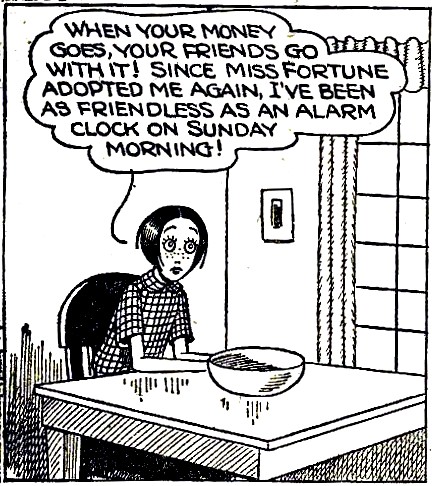


Neither writer Bill Conselman nor artist Charlie Plumb were known for other work in comics when they created their take on the rags to riches story, Cinderella. Ella Cinders was distributed by United Feature Syndicate. The daily strip began June 1, 1925, and a Sunday page was added two years later. Ella was the stepdaughter of Myrtle "Ma" Cinders, a formidable woman who made Ella do the household drudge work while her own daughters, Prissie and Lotta Pill spent their free time tormenting Ella. But Ella wasn't the sort to let that get her down. With her kid brother Blackie, she wisecracked her way through the most depressing of situations. Outside the house, she had a boyfriend with the improbable name of Waite Lifter. She was pretty in a 1920s sort of way, with straight, black hair and as big and bright a pair of eyes as you'll find anywhere in comics. But she wasn't a raving beauty, and tended to dress down, especially in the early years. Her "fairy godmother" moment did come in the form of winning a beauty contest, but that was only because the guy judging it picked her photo at random. The prize was a glamorous job at a Hollywood movie studio. When she got there she found the studio defunct, but at least she was out of the "Cinderella" situation. For the next few years, Ella and Blackie kicked around Hollywood, doing melodramatic continuity in the dailies and one-episode gags on Sundays. She never really prospered, but did okay for herself — in fact, she even got married, although her husband, Patches, spent a lot of time away, having adventures. In real life, Ella Cinders was made into a movie starring Colleen Moore and released on June 6, 1926. Other than that, Ella's only excursions off the newspaper page were a handful of Big Little Books during the 1930s and a few scattered comic books from the late '30s to the late '40s — back pages in early issues of United Feature's Tip Top and Sparkler Comics (where Nancy, Li'l Abner and Tarzan were the stars), five issues under her own logo in 1948 and '49, and a few miscellaneous items. Conselman and Plumb continued to share credits until Conselman's death in 1940, after which Plumb took credit. Plumb became well known for hiring the work out. His ghosts over the years, in both writing and art, included Hardie Gramatky (also a children's author and Disney animator), Henry Formhals (Freckles & His Friends) and Jack W. McGuire (The Red Knight). The steadiest and best known was Fred Fox (Toonerville Trolley), who took over the feature when Plumb retired in the 1950s. Fox was later replaced by Roger Armstrong (Scamp). The strip ended in 1961.
Ella Cinders reprinting strips from 9/5/1926-12/31/1926. Available on Complete Inventory USB, 64 black & white pages.
MAIN PAGE